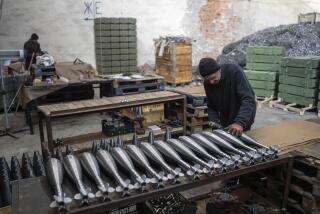Market Scene : Soviet Belt-Tightening Puts Squeeze on Polish Industry : About 30 firms face bankruptcy and closure. For others, finding Western customers will be tough because of competition and the lower quality of goods.
- Share via
OSTRZESZOW, Poland — The whole crisis seems to Wieslaw Trzcinski, the young marketing director of the factory, like a cruel practical joke, almost a hoax.
Here is a company that for 25 years has met its payroll and its obligations, filled its orders and produced a product in line with all the specifications--gleaming, intricate-looking clutch mechanisms for machine tools such as lathes and milling machinery--a product for which there was always a ready market.
The problem is that the location of that ready market has always been in one place: the Soviet Union.
But now the Soviet Union is strapped for cash, scrutinizes every dollar going out of its stricken hard-currency treasury and, effectively, has stopped buying. And the factory, the Ponar-Ostrzeszow Mechanical Equipment Manufacturing enterprise--known locally by its Polish acronym FUM--has reduced its work force to half-pay, endured strikes and strike alerts from its threatened workers. It has stalled its own creditors and raw material suppliers for four months, offering sympathy and apologies but no money.
A word that was once commonly applied to the Polish consumer market, niema (“there is none”), now applies to FUM’s bank account. It’s empty.
With 1,450 employees in a town of 13,000, FUM is by far Ostrzeszow’s largest employer. The taxes it pays account for 25% to 30% of the town’s tax revenue. “Without FUM,” said one official, exaggerating only slightly, “there would be no town.”
“This factory was built because the Soviets ordered it to be built,” Trzcinski said. “We had to do it, and so the factory was built and started right away producing, and we have been producing ever since. Now we don’t know what will happen. We are looking around, but it is not easy.”
Unfortunately for Poland, FUM is not alone in its uncertainty and peril. According to Mieczyslaw Ratajewicz, a Soviet specialist in the Ministry of Foreign Trade, about 100 Polish factories are “dramatically linked” to the Soviet Union. What does “dramatically linked” mean? “It means,” Ratajewicz said, “they have no other alternative.”
Polish trade and industry specialists say there are about 30 companies facing imminent bankruptcy and closure as a result of Soviet belt-tightening. Most manufacture heavy equipment and machinery especially targeted for the Soviets’ antiquated, low-technology industry and, as Ratajewicz noted, the products they turn out simply have no value anywhere else.
The Soviet Union has been Poland’s largest trading partner, accounting for 24.8% of its exports and 18.1% of its imports; the business relationship between the two has been complicated by the decision, beginning this year, to value this trade in dollars. Soviet and Polish negotiators are making little progress toward settling the score on past obligations, with the Polish side arguing that the money the Soviets owe Poland in rubles should offset the dollars Poland owes to Moscow.
That argument, however, reflects trade in the past.
The problem that FUM and other Polish factories face stems from the drastic cutback in new Soviet orders.
In addition, there has been a major problem in getting Soviet payment for goods already delivered. For example, Polish shipyards have launched two vessels ordered by the Soviets this year and are about to launch two more, worth a total of $40 million. The Soviets have no money to pay for them, nor, apparently $160 million more for ships now under construction and scheduled for delivery later this year.
According to trade officials, the Poles had counted on a 60% reduction of exports to Moscow, to a level of about $1.5 billion in 1991. But, at the current rate, it will come to just about 10% of what was expected--somewhere in the neighborhood of $150 million.
That is a devastating collapse and one that is being felt among all of the Soviet Union’s Eastern European trading partners--but nowhere so acutely as in Poland.
“There was a high degree of specialization in the countries of Eastern Europe,” said Trzcinski, 29, who took over as marketing director of the FUM plant in February. “For Poland, it was mostly shipbuilding and heavy equipment for our neighbors to the east. The products we make here are quite good for what they are. I would not want to say how good the equipment is that they were made for. Certainly, it is not of a Western standard.
“We have here a well-run and efficient factory. Our employees are well-trained and skilled. Our products are good. Like Swiss watches, they are not, of course. We use 95% Polish raw materials, and the quality of the steel is not quite to the standard of Western Europe, and the tolerance is not so high.”
Indeed, the clutch mechanisms, ranging in size from about that of a hockey puck to a dinner plate, appear to the unschooled eye as fine as anything that might come off the line in the United States or western Germany.
But, Trzcinski acknowledges, the appearance is an illusion. FUM, he notes, has hired a German consulting firm to help it consider alternative markets and products; the consultants immediately asked about Western European markets.
“Our Eastern customers wanted certain specifications,” he said. “Right now, Polish raw materials could not meet Western European specifications. We could change over, but it would take $3 million to $5 million just to buy equipment. Then we would have to establish a sales network, channels of business and distribution. You need market research, advertising and promotion. Already, in Western Europe, the competition in our field is very strong and well-established.”
In sum, entering this new market, even with the necessary equipment, technology and suppliers in place, would be an uphill battle.
FUM annually produces more than 500,000 clutch mechanisms for the Soviets--or has until this year--and should have been able to anticipate profits of $7.6 million or so, if orders had held at previous levels. Now, plant manager Marian Slezak says, FUM is willing to look at any alternative, including manufacturing equipment for use in food-processing plants in western Poland or components for water-treatment plants. But these prospects, he admits, seem distant.
Ostrzeszow Mayor Stanislaw Wabnic--who, like many town officials, is a former FUM employee--sees disaster for the city if the factory were to close.
Funds from the factory have established a vocational school, two secondary schools, a kindergarten and a health clinic. Emergency cash infusions from the factory last year saved the local hospital, buying drugs for its depleted pharmacy and paying off a bank loan.
If the factory were to close, Wabnic says, a quarter to a third of the town’s employees--sanitation workers, street sweepers, clerks and so on--would have to be fired.
“It would be hard to overestimate the impact of its collapse,” Wabnic said. “All the business relations, the family relations, all that would be severed. There would be the problem of unemployment and the problem of many people, educated people, leaving the town.”
Wabnic joins the factory management, Trzcinski and Slezak, in assuming that, somehow, the Soviet market will came back, at least part way. FUM recently received a letter of credit for $2.7 million, which covers 30,000 units already shipped so far this year. But this is only about 5% of plant capacity, and the Soviets made no mention of further orders.
Welcome as the payment is, it is no solution. The search will go on, amid continuing crisis.
“We have to try to do something,” Slezak said. “We can’t just give up.”
More to Read
Inside the business of entertainment
The Wide Shot brings you news, analysis and insights on everything from streaming wars to production — and what it all means for the future.
You may occasionally receive promotional content from the Los Angeles Times.










